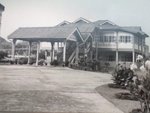Defense Professionals on 17th August 2009 reported the following:
+++++
Royal Brunei Air Force becomes first customer for BAE Systems military flying instructor training
BAE Systems has expanded its unique military flight instruction program at the company’s Tamworth Flight Training Centre with the announcement that the Royal Brunei Air Force (RBAF) has become its first customer for flying instructor training.
Two pilots from No 3 and No 5 Squadrons of the RBAF graduated at Tamworth on 7 August as Qualified Flying Instructors after attending an intensive, specially designed six-month course.
According to Lieutenant (U) Ak Mohd Zulhusmi Bin Pg Mohd Roslan from No 3 Squadron, “The Qualified Fixed Wing Course which I have undergone here at BAE Systems Tamworth has been of the highest standard.”
The RBAF has engaged BAE Systems to train its flying instructors, a move welcomed by John Quaife, General Manager of Aviation Solutions.
Mr Quaife said today that BAE Systems was the only private company capable of delivering this military instructor qualification course.
“Most air forces, including Australia’s, train their own flying instructors from within their own resources.
“For smaller air forces that require limited numbers of Flying Instructors, maintaining the overhead of a Central Flying School can be difficult, hence they often look to their allies and partners for help. The more usual solution is for military to military arrangements to be employed using the Central Flying School of the larger air force.
“However, at Tamworth, BAE Systems has been able to develop a capability to deliver a complete Qualified Flying Instructor training program for the RBAF.
“BAE Systems also trains Republic of Singapore Air Force (RSAF) qualified instructors to obtain their CASA Commercial Pilot Licence and Instructor ratings.”
“We are able to offer a turn-key solution – delivering all ground training, flying training, accommodation and messing arrangements, backed up by our experience as a military flight training provider to the Australian Defence Force since 1994.
“This unique training package is another good example of the depth of capability offered by BAE Systems at our Tamworth facility and also reflects well on the abilities of our instructional staff,” Mr Quaife concluded.
+++++
Welcome to my private journal generally on Brunei issues. Any opinions expressed are in my personal capacity. All rights to the articles are reserved.
Thursday, August 20, 2009
Tuesday, August 18, 2009
Brunei Darussalam: Ready for Take-Off
The Oxford Business Group on 18th August reported the following:
+++++
Brunei Darussalam: Ready For Take-Off
18 August 2009
Brunei Darussalam has long harboured ambitions of becoming a major transport and trans-shipment hub for the East ASEAN Growth Area (BIMP-EAGA), as well as taking an increased slice of the trade from regional giants such as China and Singapore.
To this end, Brunei Darussalam has been developing its transport infrastructure as part of its long-term programme to expand and diversify the economy. While much of the focus of this programme has been on the $1.5bn Pulau Muara Besar port development, the Sultanate is also looking to capitalise on its central position in the region to build up its air freight capability and tourist-handling capacity.
There had been speculation in the local media in the preceding months that the government might construct a second international airport in the Belait district, though with the minister's announcement it now seems this proposal has been shelved in favour of expanding the capacity of the existing Brunei International Airport (BIA).
In late March, the government ruled out a proposal to build a new airport to cater for the growing airborne tourism and freight traffic, with the minister of communications, Pehin Dato Haji Abu Bakar Haji Apong, saying there was not sufficient space to devote to constructing a new facility.
"A consultant was assigned to monitor the situation recently but due to the amount of land needed to build a new airport, which is 8 km by 5 km, the plan was set aside, and a plan has been handed over to a local consultant for the expansion of the existing airport," the minister said on March 23.
Rather than build a new airport, the focus of upgrading Brunei Darussalam's air transport infrastructure would be on the BIA, he added.
And this capacity is in need of building, at least in passenger-handling terms, with the BIA having reached its planned limit of 1.5m arrivals and departures in 2007. Under a master plan drafted over the past two years, BIA is to undergo a $363.5m facelift to upgrade it to the status of an airline and cargo hub, giving it the capacity to process 4.5m passengers a year by 2024, with the potential to expand to 6m by 2030.
Just as importantly, the plan also includes a major expansion of the BIA's freight-handling infrastructure, which unlike its passenger processing facilities is currently underutilised.
The move would be a timely one if Brunei Darussalam is to achieve its ambition of being an airfreight hub and could help revive the dwindling air cargo export trade, which has seen volume drop by more than 50% in the past six years.
According to a report issued by the Brunei International Air Cargo Centre (BIACC), the company established in 2001 to handle air cargo activities into and out of the Sultanate, outgoing freight levels have fallen from 2869 tonnes exported in the 12 months ending March 2004 to 1260 tonnes in the April 2007-March 2008 period.
Though levels of cargo imports only registered a minor fall, easing 1% from the 7719 tonnes flown in during the April 2003-March 2004 period to 7627 tonnes in the year ending March 2008, this flat line contrasted with the steady expansion of Brunei Darussalam's economy over that period.
Among the reasons cited by Ariffin Hj Emran, the general manager of BIACC, for the downturn in cargo movements, especially exports, was the decline in the country's once-vibrant textile sector and the shift by national flag carrier Royal Brunei Airlines (RBA) to using smaller aircraft in 2003 and 2004.
"Since 90% of air cargo is handled by RBA, their refleeting programme definitely had an impact on cargo throughput," Ariffin said in an interview with the Brunei Times on July 8. "In the past, bigger planes like the 767s were used for regional routes but RBA has downscaled its fleet."
This downsizing has reduced RBA's cargo-carrying capacity, with the airline's newer fleet, consisting of six Boeing B767-300s, two Airbus A320s and two A319s, having less space for freight, he said.
While RBA's own cargo-carrying capacity may have been reduced in recent years, a new firm has stepped in to fill at least part of the gap. In mid-June, Syabas Aviation, a newly formed local company, began cargo services out of BIA, flying twice a week to Singapore using two leased Antonov freight haulers.
Sheikh Abas bin Sheikh Mohamed, Syabas' chairman, believes that the airline can tap into a growing niche market, saying there is an increasing demand for quick movement of special cargos.
"Petroleum exploration, for instance, requires logistical products such as drilling parts," he told local media on June 12. "Certain work at the oilfield needs to be speeded up and faster delivery is required."
Though stressing that Syabas was not competing with the existing air cargo flights, merely complementing existing services, Sheikh Abas said that for the first time in 30 years, Brunei Darussalam now had a dedicated air forwarding service.
As is the case with maritime cargo services, Brunei Darussalam will always face stiff competition across the region as it seeks to gain a greater slice of the airfreight market. Both Thailand and Malaysia have embarked on projects to expand the freight-handling capacities of some of their major airports, while Singapore's Changi Airport has a total airfreight capacity of around 4m tonnes.
With improvements and upgrades in the works, BIA's cargo-handling capacity is expected to boost the local economy and allow the airport to service the freight needs not only of the Sultanate itself but also of the nearby Malaysian states of Sabah and Sarawak, and further across the BIMP-EAGA.
+++++
Brunei Darussalam: Ready For Take-Off
18 August 2009
Brunei Darussalam has long harboured ambitions of becoming a major transport and trans-shipment hub for the East ASEAN Growth Area (BIMP-EAGA), as well as taking an increased slice of the trade from regional giants such as China and Singapore.
To this end, Brunei Darussalam has been developing its transport infrastructure as part of its long-term programme to expand and diversify the economy. While much of the focus of this programme has been on the $1.5bn Pulau Muara Besar port development, the Sultanate is also looking to capitalise on its central position in the region to build up its air freight capability and tourist-handling capacity.
There had been speculation in the local media in the preceding months that the government might construct a second international airport in the Belait district, though with the minister's announcement it now seems this proposal has been shelved in favour of expanding the capacity of the existing Brunei International Airport (BIA).
In late March, the government ruled out a proposal to build a new airport to cater for the growing airborne tourism and freight traffic, with the minister of communications, Pehin Dato Haji Abu Bakar Haji Apong, saying there was not sufficient space to devote to constructing a new facility.
"A consultant was assigned to monitor the situation recently but due to the amount of land needed to build a new airport, which is 8 km by 5 km, the plan was set aside, and a plan has been handed over to a local consultant for the expansion of the existing airport," the minister said on March 23.
Rather than build a new airport, the focus of upgrading Brunei Darussalam's air transport infrastructure would be on the BIA, he added.
And this capacity is in need of building, at least in passenger-handling terms, with the BIA having reached its planned limit of 1.5m arrivals and departures in 2007. Under a master plan drafted over the past two years, BIA is to undergo a $363.5m facelift to upgrade it to the status of an airline and cargo hub, giving it the capacity to process 4.5m passengers a year by 2024, with the potential to expand to 6m by 2030.
Just as importantly, the plan also includes a major expansion of the BIA's freight-handling infrastructure, which unlike its passenger processing facilities is currently underutilised.
The move would be a timely one if Brunei Darussalam is to achieve its ambition of being an airfreight hub and could help revive the dwindling air cargo export trade, which has seen volume drop by more than 50% in the past six years.
According to a report issued by the Brunei International Air Cargo Centre (BIACC), the company established in 2001 to handle air cargo activities into and out of the Sultanate, outgoing freight levels have fallen from 2869 tonnes exported in the 12 months ending March 2004 to 1260 tonnes in the April 2007-March 2008 period.
Though levels of cargo imports only registered a minor fall, easing 1% from the 7719 tonnes flown in during the April 2003-March 2004 period to 7627 tonnes in the year ending March 2008, this flat line contrasted with the steady expansion of Brunei Darussalam's economy over that period.
Among the reasons cited by Ariffin Hj Emran, the general manager of BIACC, for the downturn in cargo movements, especially exports, was the decline in the country's once-vibrant textile sector and the shift by national flag carrier Royal Brunei Airlines (RBA) to using smaller aircraft in 2003 and 2004.
"Since 90% of air cargo is handled by RBA, their refleeting programme definitely had an impact on cargo throughput," Ariffin said in an interview with the Brunei Times on July 8. "In the past, bigger planes like the 767s were used for regional routes but RBA has downscaled its fleet."
This downsizing has reduced RBA's cargo-carrying capacity, with the airline's newer fleet, consisting of six Boeing B767-300s, two Airbus A320s and two A319s, having less space for freight, he said.
While RBA's own cargo-carrying capacity may have been reduced in recent years, a new firm has stepped in to fill at least part of the gap. In mid-June, Syabas Aviation, a newly formed local company, began cargo services out of BIA, flying twice a week to Singapore using two leased Antonov freight haulers.
Sheikh Abas bin Sheikh Mohamed, Syabas' chairman, believes that the airline can tap into a growing niche market, saying there is an increasing demand for quick movement of special cargos.
"Petroleum exploration, for instance, requires logistical products such as drilling parts," he told local media on June 12. "Certain work at the oilfield needs to be speeded up and faster delivery is required."
Though stressing that Syabas was not competing with the existing air cargo flights, merely complementing existing services, Sheikh Abas said that for the first time in 30 years, Brunei Darussalam now had a dedicated air forwarding service.
As is the case with maritime cargo services, Brunei Darussalam will always face stiff competition across the region as it seeks to gain a greater slice of the airfreight market. Both Thailand and Malaysia have embarked on projects to expand the freight-handling capacities of some of their major airports, while Singapore's Changi Airport has a total airfreight capacity of around 4m tonnes.
With improvements and upgrades in the works, BIA's cargo-handling capacity is expected to boost the local economy and allow the airport to service the freight needs not only of the Sultanate itself but also of the nearby Malaysian states of Sabah and Sarawak, and further across the BIMP-EAGA.
Subscribe to:
Posts (Atom)











